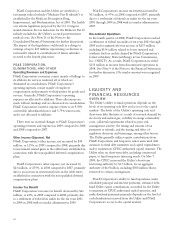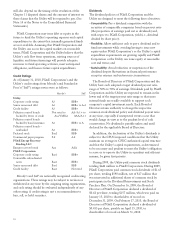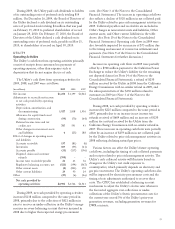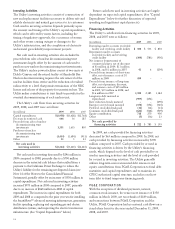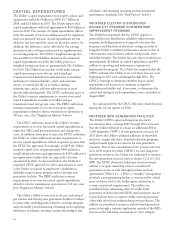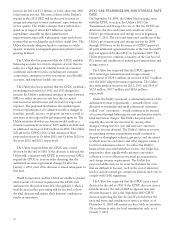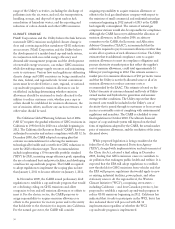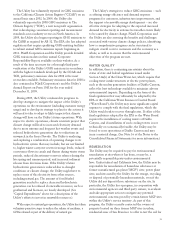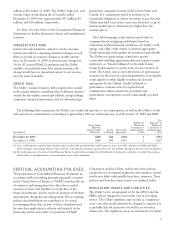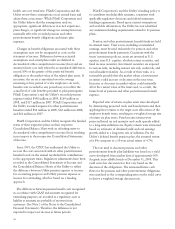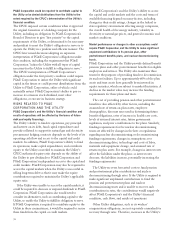PG&E 2009 Annual Report Download - page 33
Download and view the complete annual report
Please find page 33 of the 2009 PG&E annual report below. You can navigate through the pages in the report by either clicking on the pages listed below, or by using the keyword search tool below to find specific information within the annual report.ELECTRIC TRANSMISSION OWNER RATE CASES
The Utility generally files a TO rate case every year to
request that the FERC authorize the Utility to collect an
annual retail transmission revenue requirement at rates
based on the Utility’s forecast of customer demand for the
particular rate case year. The Utility’s ability to recover the
FERC-authorized revenue requirement is subject to the
actual volume of electricity sales for the particular rate case
year. The Utility is typically able to collect the proposed
new rates based on the amount of the requested annual
revenue requirement before the FERC issues a decision
authorizing new rates. The rates collected before the FERC
issues a decision are subject to refund to customers.
On June 18, 2009, the FERC approved a settlement that
sets the Utility’s annual retail transmission base revenue
requirement at $776 million, effective March 1, 2009. As
part of the settlement, the Utility will refund any over-
collected amounts to customers, with interest, through an
adjustment to rates in 2011.
On July 30, 2009, the Utility filed an application with
the FERC requesting an annual retail transmission revenue
requirement of $946 million. The proposed rates represent
an increase of $170 million over current authorized
revenue requirements. On September 30, 2009, the FERC
accepted the Utility’s application making the proposed
rates effective March 1, 2010 subject to refund following
the conclusion of hearings and the outcome of judge-
supervised settlement discussions.
ENERGY EFFICIENCY PROGRAMS
AND INCENTIVE RATEMAKING
The CPUC established a ratemaking mechanism to provide
incentives to the California investor-owned utilities to meet
the CPUC’s energy savings goals through implementation
of the utilities’ energy efficiency programs. As originally
established, this mechanism was intended to apply to the
2006 through 2008 and 2009 through 2011 program cycles.
In January 2009, the CPUC established a new rulemaking
proceeding to modify the mechanism for energy efficiency
programs in 2009 and future years. It is uncertain what
modifications will ultimately be adopted by the CPUC.
On December 17, 2009, in accordance with the existing
mechanism, the CPUC awarded the Utility incentive
revenues of $33.4 million based on the energy savings
achieved through implementation of the Utility’s energy
efficiency programs during the 2006 through 2008 program
cycle. (This amount is in addition to incentive revenues of
$41.5 million awarded by the CPUC to the Utility in
December 2008 based on the Utility’s 2006 through 2007
program performance.) Consistent with the incentive award
process previously adopted by the CPUC, the CPUC held
back an additional $40.3 million of incentive revenues. The
additional amount of incentive revenues that the Utility
could receive, if any, will be determined after final energy
savings for the 2006 through 2008 program cycle are
verified and the true-up process is completed in 2010. The
CPUC adopted a schedule for the final true-up process that
calls for a final decision by the end of 2010.
With respect to the utilities’ 2009 through 2011 energy
efficiency programs, the CPUC issued a decision on
September 24, 2009 that changed the program cycle to
cover 2010 through 2012. The CPUC also authorized the
Utility to continue to collect the bridge funding for its
2009 programs and authorized the Utility to collect $1.3
billion to fund its 2010 through 2012 programs, a 42%
increase over the amount authorized for the 2006 through
2008 programs. The CPUC has not yet determined how
the existing incentive mechanisms will be modified.
Therefore, the amount of incentive revenues the Utility
may earn for implementation of its energy efficiency
programs in 2009 and future years, if any, is uncertain.
DIABLO CANYON RELICENSING APPLICATION
The NRC oversees the licensing, construction, operation,
and decommissioning of nuclear facilities, including the
two nuclear generating units at Diablo Canyon and the
Utility’s retired nuclear generating unit at Humboldt Bay.
NRC regulations require extensive monitoring and review
of the safety, radiological, environmental, and security
aspects of these facilities. The NRC operating license for
Diablo Canyon Unit 1 expires in November 2024 and the
NRC operating license for Diablo Canyon Unit 2 expires
in August 2025. On November 24, 2009, the Utility filed
an application to request the NRC to renew each of the
operating licenses for Diablo Canyon for 20 years, until
November 2044 for Unit 1 and August 2045 for Unit 2,
citing a critical need in California for the long-term supply
of clean, affordable, and reliable electricity. The license
renewal process is expected to take several years as the
NRC holds public hearings and conducts safety and
environmental analyses and site audits. On January 29,
2010, the Utility requested that the CPUC authorize the
Utility to recover in rates the costs of seeking license
renewal. The Utility currently estimates that it will incur
$85 million through 2014 in connection with the
relicensing process.
ENVIRONMENTAL MATTERS
The Utility’s operations are subject to extensive federal,
state, and local laws and permits relating to the protection
of the environment and the safety and health of the
Utility’s personnel and the public. (See “Risk Factors”
below.) These laws and requirements relate to a broad
29



